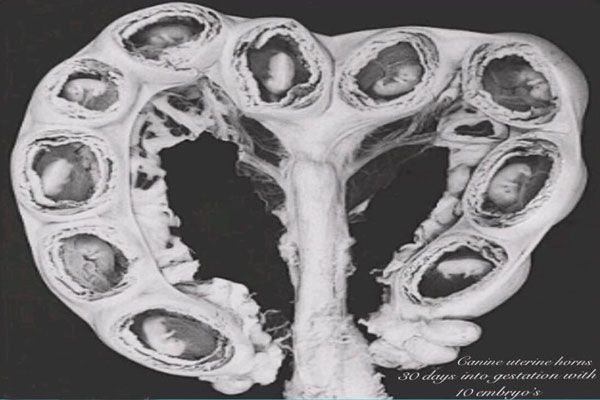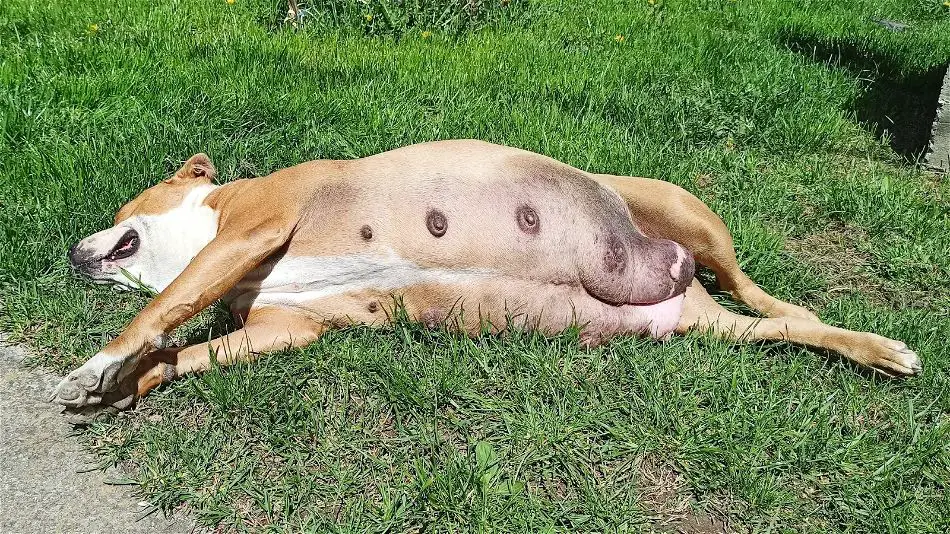Introduction
This article will provide an overview of where puppies are located inside a pregnant dog. We will look at the anatomy of a pregnant dog’s reproductive system, the different stages of pregnancy, and the development of the puppies over the gestation period. Understanding the location and growth of puppies in utero is useful knowledge for breeders, veterinarians, and anyone planning to foster or own a pregnant dog.
The Uterus
The uterus is where puppies develop during pregnancy. The uterus is a Y-shaped muscular organ located in the abdomen of female dogs between the bladder and rectum. It consists of a body, two uterine horns, and the cervix. When a dog becomes pregnant after mating with a male, the fertilized eggs travel to the uterus and attach themselves to the uterine wall. The embryos then embed themselves in the wall of the uterus where they will grow and develop into puppies over the course of the pregnancy.
Right and Left Uterine Horns
A dog’s uterus branches into two long, curved horns where puppies grow during pregnancy. These are known as the right and left uterine horns. The horns are connected to the main body of the uterus but extend backward into the abdomen.
According to veteriankey.com, “The uterine horns in dogs are long and tortuous. The two uterine horns fuse to form a relatively small uterine body just cranial to the cervix.” [1]
The uterine horns provide the space and implantation sites for the developing puppies to grow. The right and left horns allow more room for the fetuses compared to a single uterus body. During gestation, the puppies spread out along the length of each horn while embedded in the uterine wall.
Gestation Period
The gestation period for dogs is approximately 63 days, counted from the date of successful breeding. This is the length of time it takes for puppies to fully develop in the uterus before birth.
During this 9 week period, the fertilized eggs will implant in the lining of the uterus, the embryos will grow and develop major organs and structures, and the fetuses will continue maturing until ready for delivery.
The 63 day gestation is an average across all dog breeds. Some breeds, like Chihuahuas, may deliver a bit earlier at around 60 days. For larger breeds like Great Danes, the pregnancy can last for up to 65 days.

It’s important for breeders and owners to be aware of the 63 day timeline when planning for their dog’s pregnancy and delivery. Knowing the due date will allow proper preparation and care as the big day approaches.
Some key things happen during each week of canine gestation:
Understanding the 63 day normal gestation period in dogs allows owners to provide attentive veterinary care, nutrition, and proper facilities for the pregnant mother and developing puppies. Tracking the timeline prepares breeders for any potential whelping complications as well.
Litter Size
The average litter size for dogs is 4-6 puppies, though this number can vary significantly based on the breed of the dog [1]. Small breeds tend to have smaller litters, usually between 1-4 puppies, while larger breeds can have litters of 8 puppies or more. There are also some breeds that are known for having particularly large litters, such as Labrador Retrievers which often have 6-10 puppies and Bulldogs which average 8-10 puppies per litter.
Though 4-6 puppies is considered average, some litters can be much larger. The largest known litter of puppies was 24 puppies born to a Neapolitan Mastiff in the UK in 2004 [1]. While litters over 10 puppies are less common, they are seen more frequently in larger breed dogs. The number of puppies ultimately depends on a variety of factors like the size and health of the mother dog.
Fetal Development
A dog’s pregnancy lasts approximately 63 days from conception to birth, though this can vary by several days depending on the individual dog. During this time, the fertilized eggs undergo remarkable changes as they develop into puppies. Here is an overview of a dog pregnancy week-by-week:
Week 1-2: Fertilization occurs, and the eggs travel to embed in the uterus. Cell division begins shortly after fertilization.
Week 3: The embryos implant into the uterus, signaling the start of the fetal stage. Early organ formation begins. Their heartbeats become detectable.

Week 4: The embryos develop into fetuses. Their skeletons begin to harden as cartilage and bone starts to develop. Their facial features take shape. Their limbs, toes, and claws are visible.
Week 5: The fetuses continue developing rapidly. Their eyelids fuse shut. Their claws become hardened. Their coats begin growing. They develop teeth buds. Their skeletons harden further as cartilage turns to bone.
Week 6: The puppies’ skeletons are almost fully developed, though still soft. Their coats fill out, and their whiskers and eyebrows form. Their paw pads develop, and their eyelids separate. Brainwave activity can be detected.
Week 7: The puppies start to move around in the womb. Their eyelids open partially. Claws harden completely. All organs and body systems continue developing.
Week 8: The puppies gain significant weight and size. Their coats are fully formed. They can open and close their eyes and mouth. Senses like hearing, smell, and taste develop further.
Weeks 9-10: The puppies position themselves for birth, with their noses facing the cervix. They gain the most weight now as fat stores develop. The amniotic sac fills with fluid. Milk teeth emerge behind the gums.
Preparing for Birth
As a pregnant dog nears the end of her gestation period, there are several signs indicating that labor is imminent. One of the most notable signs is changes in the dog’s vulva and mammary glands. The vulva often appears swollen, enlarged, and relaxed in preparation for the birthing process. The mammary glands will also enlarge and may start producing milk. Additionally, the dog’s body temperature will drop below 100°F within 24 hours of labor starting.
There are also several discharge changes that signal impending labor. Around 2 weeks before delivery, the mucus plug that seals the cervix during pregnancy may be expelled. This discharge is thick, opaque, and can be tinged with blood. Clear or cloudy vaginal discharge may increase and darken as labor nears. Increased urination and bowel movements, restlessness, and nesting behaviors like digging or shredding bedding are other signs birth is close.

Once contractions start, they may begin irregularly and then progress closer together. Strong, stage two labor contractions are typically less than 2 minutes apart. Panting, whining, and behavioral changes like anxiety or reclusiveness often accompany this stage. Within 24 hours of the start of stage two labor, puppies should be born. Recognizing these signs helps owners properly prepare for their dog’s impending delivery.
Source: https://llexupnuw.korneraudio.de/
The Birth Process
The birth process for dogs is divided into three stages of labor:
Stage 1 labor involves the cervix dilating and contractions beginning. This stage can last 6-12 hours. During this stage, the dog will appear restless, shiver, vomit, and pant. Her temperature will drop below 100°F. When contractions are about 30-60 minutes apart, stage 1 is nearing completion.
Stage 2 labor is the active pushing and delivery stage. The dog’s water will break, and puppies will start being pushed out one by one. Stage 2 labor usually lasts up to 4 hours, but the first puppy should be born within 1 hour of active pushing. Puppies are usually born every 15-60 minutes.
Stage 3 labor involves the expulsion of the placentas after all the puppies have been delivered. This stage may last up to 4 hours. The mother will continue to have small contractions to expel the placentas attached to each puppy. This stage is complete when all placentas have passed.
It’s critical to monitor the mother closely through the birthing process. Contact a veterinarian if there is prolonged labor or any concerns. For more details see the Purina article on dog birth stages.

After Welping
After giving birth, also known as welping, the mother dog will require additional care and attention. The puppies should begin nursing soon after birth to receive vital nutrients and antibodies from the mother’s first milk, known as colostrum (Doggozila). The mother will continue producing milk to nurse the puppies for the first few weeks of life.
It is important that the mother dog eats a high-quality puppy food diet and has access to plenty of fresh water while nursing. The pregnant dog’s nutrition requirements increase dramatically after giving birth. Nutrition is important for milk production and the mother’s general health and recovery after delivery.
The mother dog will need a whelping box or secluded space away from other household pets for nursing and bonding with puppies. Monitor the mother for signs of fatigue, infection, or postpartum health issues. Keep the environment clean and make sure the puppies stay warm. Weigh the puppies regularly to ensure they are gaining weight and nursing properly.
While the puppies will spend most of their time eating and sleeping, gentle socialization and handling should begin within the first couple weeks of life. Consult your veterinarian about puppy vaccinations and medical care to ensure the newborn puppies get off to a healthy start.
Conclusion
In summary, puppies begin their development in the left and right uterine horns of a pregnant dog. During the approximately 9 week gestation period, they grow from a single fertilized cell into recognizable puppies. The puppies go through several developmental stages, starting as embryos before developing into fetuses around 3-4 weeks. By 6-7 weeks, their organs, bones, and features are formed and they continue to grow in size during the final weeks. Their locations shift within the uterine horns as they grow larger. Just before birth around week 9, the puppies reposition themselves near the cervix, ready to be born. After a pregnant dog welps her litter, the incredible journey from conception to birth is complete.